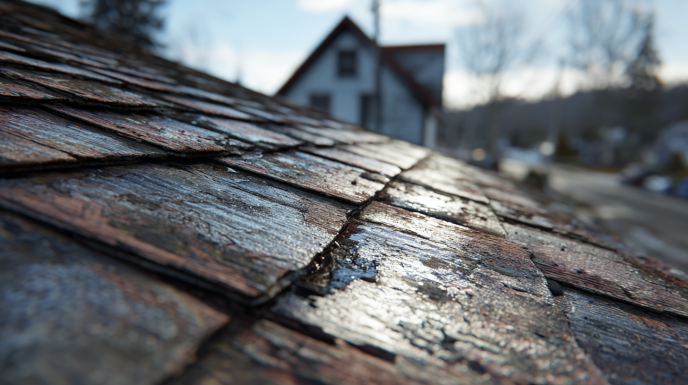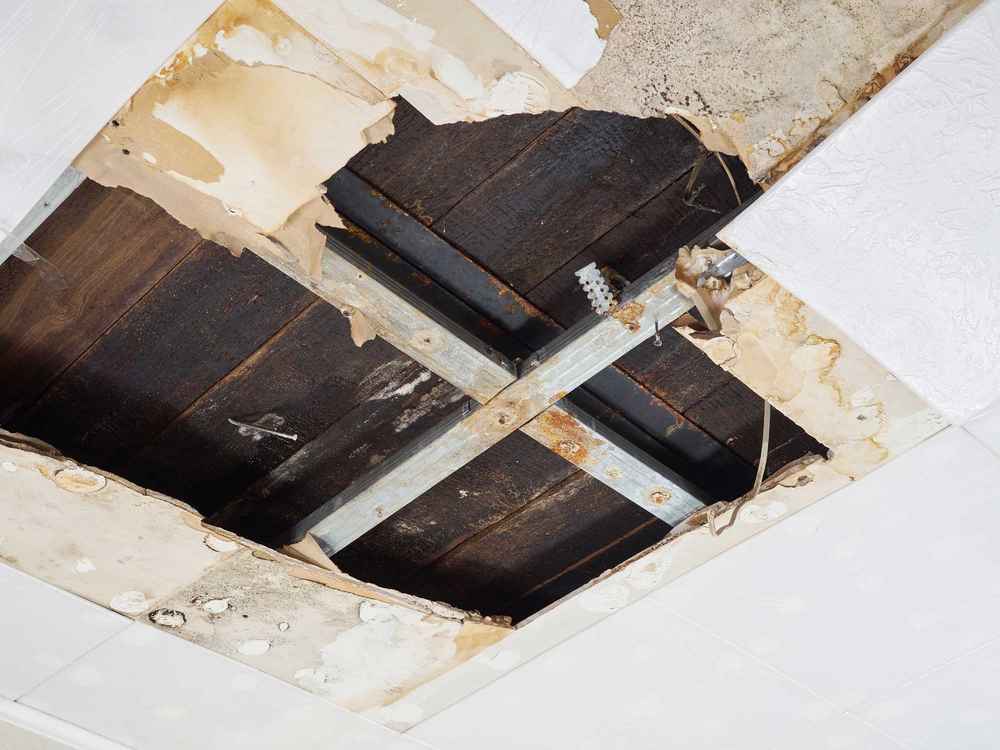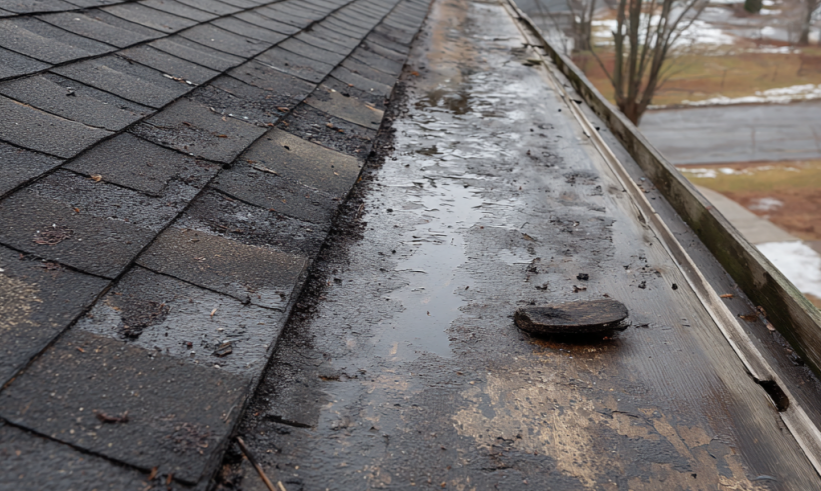Your home is more than a place to rest—it’s a significant investment, a sanctuary, and your first line of defense against the elements. One of the most overlooked threats to your home’s structural integrity is a roof leak. While some leaks are obvious, many develop slowly and remain hidden until serious damage occurs. Detecting roof leaks early is critical, as they can lead to water damage, mold growth, and costly structural repairs.
In this guide, we’ll break down the most common roof leak warning signs that homeowners often miss, explain why they happen, and provide actionable steps to protect your home. By learning to recognize these subtle signs, you can take proactive measures to prevent small problems from turning into major headaches.
Water Stains on Ceilings or Walls: The Subtle First Sign of a Roof Leak
One of the earliest indicators of a roof leak is water stains. These stains may appear as yellow or brownish patches on ceilings, walls, or around light fixtures. They often form slowly and can easily be mistaken for plumbing issues or even dirt.
Why homeowners miss it: Many people ignore faint discoloration because it doesn’t appear urgent. However, even small water stains indicate that moisture is seeping into your home and could be weakening the underlying structure.
Actionable tip: Check your attic after heavy rains. Inspect the underside of the roof deck for water, damp spots, or streaks. Early detection here can prevent mold and rotting wood.
Dripping Water and Active Leaks: Don’t Ignore the Obvious
While some roof leaks are subtle, others manifest as dripping water from ceilings, walls, or even light fixtures. It might seem minor at first, but consistent dripping can be a red flag of serious roof damage.
Why you shouldn’t wait: Even a slow leak allows water to reach insulation, electrical wiring, and the wood framing of your home. Over time, this can lead to mold growth, structural decay, and costly repairs.
Actionable tip: Place a bucket or container under the leak temporarily, but schedule a professional roofing inspection immediately. Temporary fixes like sealants may provide relief, but only a licensed contractor can ensure proper repair.
Missing, Cracked, or Curling Shingles: A Clear Sign of Vulnerability
Shingles are your roof’s first line of defense. Damaged or missing shingles create gaps that allow water to penetrate your home. Signs to watch for include:
- Cracked or curling shingles
- Granule loss on shingles
- Shingles that are completely missing after a storm
Actionable tip: Inspect your roof after severe weather events. Look for shingles that are loose, brittle, or missing entirely. Replacing damaged shingles promptly is one of the most cost-effective ways to prevent leaks.
Granules in Gutters: A Hidden Warning Sign
Roof shingles contain protective granules that shield your home from sun exposure and water damage. When shingles deteriorate, these granules accumulate in your gutters.
Why homeowners miss it: It often looks like debris from leaves or other natural sources, so many people dismiss it. Excessive granule loss can weaken shingles and leave your roof vulnerable to leaks.
Actionable tip: Clean and inspect your gutters regularly. If you notice granule buildup, it may be time for a professional roof assessment.
Sagging Roof Deck: Structural Warning Signs You Can’t Ignore
Sagging or uneven areas in your roofline are a serious warning sign of water damage. Moisture can weaken the roof deck over time, creating dips or sagging spots visible from the attic or exterior of your home.
Why homeowners miss it: Subtle sagging may not be noticeable until it’s advanced, and minor unevenness can be mistaken for normal roof settling.
Actionable tip: Schedule professional inspections if you notice dips, uneven spots, or a sagging attic ceiling. Addressing the underlying issue quickly can prevent dangerous structural failures.
Mold, Mildew, and Musty Odors: Health Risks Hidden Behind Roof Leaks
Persistent musty odors or visible mold in your attic or ceilings often indicate ongoing moisture problems. Mold not only damages insulation, drywall, and wood but can also pose serious health risks for your family, including respiratory issues and allergic reactions.
Why homeowners miss it: Mold often develops behind walls or in poorly ventilated spaces, making it invisible until it spreads.
Actionable tip: Regularly inspect the attic and roofline for signs of mold or mildew. Improving ventilation and addressing leaks promptly are key steps in preventing long-term damage.
Ice Dams and Frost Buildup: Cold Weather Warning Signs
In colder climates, ice dams can form along the roofline, causing water to back up under shingles and seep into your home. This is often the result of inadequate insulation and ventilation. Repeated freeze-thaw cycles accelerate roof damage.
Actionable tip: Keep your attic properly insulated and ventilated. During winter, remove ice buildup carefully, and have a roofing professional check for damage after thawing periods.
Common Roof Leak Sources Homeowners Often Miss
Even vigilant homeowners can overlook certain roof areas prone to leaks. Pay attention to:
- Flashing around chimneys and vents: Cracks or gaps here are common leak sources.
- Skylights: Poor seals or cracked glass allow water entry.
- Roof valleys: Where two roof slopes meet, water can pool and seep through.
- Plumbing stacks and vents: Aging seals may fail over time.
- Attic condensation: Inadequate ventilation causes moisture buildup and potential leaks.
By knowing these vulnerable points, you can focus inspections where leaks are most likely to develop.
Actionable Steps to Prevent Roof Leaks
Taking preventive measures can save thousands in repair costs. Key steps include:
- Conducting regular roof inspections at least twice a year and after storms.
- Maintaining gutters and downspouts to ensure proper water drainage.
- Trimming overhanging tree branches to prevent shingle damage.
- Addressing leaks immediately, even if they seem minor.
- Investing in professional inspections for early detection of hidden issues.
Why Professional Roof Inspections Matter
While homeowners can spot some warning signs, a licensed roofing contractor has the expertise to identify hidden problems that could cause leaks in the future. Professional inspections include:
- Checking shingles, flashing, and roof vents for damage
- Assessing roof structure and deck integrity
- Detecting early signs of water infiltration or mold
- Providing recommendations for repairs or replacements before damage escalates
Don’t Wait Until It’s Too Late
Roof leaks can start small, but their effects can be significant and expensive. Spotting early warning signs and taking prompt action is the best way to protect your home, family, and investment. Regular inspections, maintenance, and professional guidance are essential for keeping your roof in top condition.
If you suspect a leak, notice unusual stains, or simply want peace of mind, contact Port Orchard Roofing in Port Orchard, WA. Our expert team provides thorough inspections, reliable repairs, and professional advice to ensure your roof—and your home—remains safe and secure. Don’t wait for a small problem to turn into a major headache—schedule your inspection today.




 (360) 649-7801
(360) 649-7801


